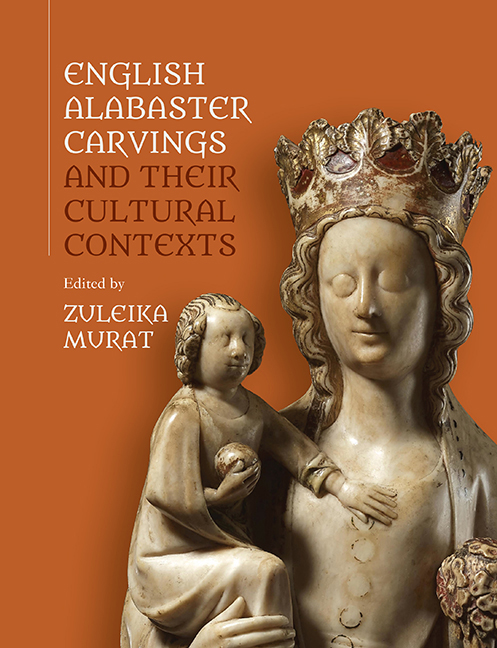Book contents
- Frontmatter
- CONTENTS
- List of Illustrations
- Acknowledgements
- List of Contributors
- Introduction
- 1 ‘Burton-Upon-Trent, Not Nottingham.’ the Evolving Study Of Medieval English Alabaster Sculpture
- 2 Stone to Ensure Victory and to Generate Friendships. On The Meaning of Alabaster
- 3 Contextualising English Alabasters in the Material Culture of the Medieval Mediterranean
- 4 English Alabaster Images As Recipients of Music in the Long Fifteenth Century: English Sacred Traditions in a European Perspective
- 5 Contextualising Alabasters in Their Immersive Environment. The ‘Ancona D'Allabastro Di Diverse Figure’ of the Novalesa Abbey: Meaning and Function
- 6 Alabaster Carvings in Late-Medieval Lincolnshire
- 7 ‘Tabernacles, Howsynges and Other Things’. Three Alabasters From the Burrell Collection in Context
- 8 Conservation Study of Three Alabaster Carvings From the Burrell Collection, Glasgow Museums
- 9 ‘Smooth as Monumental Alabaster’. the Alabaster Tomb Industry in England 1550–1660
- 10 Merchants’ Tombs in Alabaster
- 11 Exploring Alice: the Theological, Socio-Historical, and Anatomical Context of the De La Pole Cadaver Sculpture
- Bibliography
- Index
- Already Published
6 - Alabaster Carvings in Late-Medieval Lincolnshire
Published online by Cambridge University Press: 14 September 2019
- Frontmatter
- CONTENTS
- List of Illustrations
- Acknowledgements
- List of Contributors
- Introduction
- 1 ‘Burton-Upon-Trent, Not Nottingham.’ the Evolving Study Of Medieval English Alabaster Sculpture
- 2 Stone to Ensure Victory and to Generate Friendships. On The Meaning of Alabaster
- 3 Contextualising English Alabasters in the Material Culture of the Medieval Mediterranean
- 4 English Alabaster Images As Recipients of Music in the Long Fifteenth Century: English Sacred Traditions in a European Perspective
- 5 Contextualising Alabasters in Their Immersive Environment. The ‘Ancona D'Allabastro Di Diverse Figure’ of the Novalesa Abbey: Meaning and Function
- 6 Alabaster Carvings in Late-Medieval Lincolnshire
- 7 ‘Tabernacles, Howsynges and Other Things’. Three Alabasters From the Burrell Collection in Context
- 8 Conservation Study of Three Alabaster Carvings From the Burrell Collection, Glasgow Museums
- 9 ‘Smooth as Monumental Alabaster’. the Alabaster Tomb Industry in England 1550–1660
- 10 Merchants’ Tombs in Alabaster
- 11 Exploring Alice: the Theological, Socio-Historical, and Anatomical Context of the De La Pole Cadaver Sculpture
- Bibliography
- Index
- Already Published
Summary
The medieval county of Lincolnshire had a flourishing economy which coincided with the period of greatest output from the alabaster quarries and it might therefore be expected that there would have been considerable markets for alabaster carvers’ work in the region. Its geographical position, lying between the alabaster quarry sites of the East Midlands and the sea, might also have encouraged craftsmen based in the county to produce work for export around the coast and to continental Europe. Depredations due to the Reformation have been particularly severe in Lincolnshire, however, and virtually all the medieval monastic sites were razed to the ground with the consequent loss of most of their contents, whether works of religious art or effigial monuments, including those of alabaster, and so our knowledge of one important area of patronage is limited. Losses from parish churches were equally great but there is a range of documentary evidence, and there are some survivals. Lincoln had a Guild of St Luke that was founded in 1525 for ‘alabaster men’ together with painters, stainers and gilders, and this establishes that carvers were at work at the end of the medieval period in the region, but evidence for the earlier period is less clear. Combining the documentary evidence with the number of rediscovered works from across Lincolnshire does however allow us to comment on the popularity of the material. There is a particular concentration of evidence from the north-west corner of the county, the Isle of Axholme. This is a low-lying area at the confluence of the river Trent with the Humber, and the presence there of gypsum pits suggests a possible quarrying and production centre in the medieval period that warrants investigation.
TOMBS AND MONUMENTS
Perhaps surprisingly, medieval Lincolnshire patrons, or masons, did not choose alabaster for tomb monuments very often. There is no Lincolnshire equivalent to the series of monuments to be found in churches in Nottinghamshire or Derbyshire to suggest a workshop in the region, and it is noticeable that none of the medieval tombs in Lincoln Cathedral is of alabaster. The Willoughby alabaster tombs at Spilsby, Lincolnshire, are an exception, and it has been plausibly suggested that the two monuments to the second and third barons, from the last quarter of the fourteenth century, are metropolitan rather than Midlands work.
- Type
- Chapter
- Information
- English Alabaster Carvings and their Cultural Contexts , pp. 150 - 172Publisher: Boydell & BrewerPrint publication year: 2019



